charging MITSUBISHI OUTLANDER PHEV 2014 (in English) User Guide
[x] Cancel search | Manufacturer: MITSUBISHI, Model Year: 2014, Model line: OUTLANDER PHEV, Model: MITSUBISHI OUTLANDER PHEV 2014Pages: 442, PDF Size: 19.04 MB
Page 26 of 442

Fuel selectionE00200104275Recom-
mended fuelUnleaded petrol octane number(EN228) 95 RON or higherCAUTIONlThe use of leaded fuel can result in serious
damage to the engine and catalytic convert- er. Do not use leaded fuel.NOTEl Poor quality petrol can cause problems such
as difficult starting, stalling, engine noise
and hesitation. If you experience these prob- lems, try another brand and/or grade of pet-
rol.
If the check engine warning lamp flashes,
have the system checked as soon as possible at a MITSUBISHI MOTORS Authorized
Service Point.
E10 type petrol
The petrol engine are compatible with E10
type petrol (containing 10 % ethanol) con- forming to European standards EN 228.
CAUTIONl Do not use more than 10 % concentration of
ethanol (grain alcohol) by volume.
Use of more than 10 % concentration may
lead to damage to your vehicle fuel system,
engine, engine sensors and exhaust system.Filling the fuel tank
E00200203804WARNINGlWhen handling fuel, comply with the safe-
ty regulations displayed by garages and
filling stations.
l Gasoline is highly flammable and explo-
sive. You could be burned or seriously in-
jured when handling it. When refueling
your vehicle, always put the operation mode of the power switch in OFF and
keep away from flames, sparks, and smoking materials. Always handle fuel in
well-ventilated outdoor areas.
l Before removing the fuel cap, be sure to
get rid of your body’s static electricity by
touching a metal part of the car or the fuel pump. Any static electricity on your
body could create a spark that ignites fuel vapour.WARNINGl Perform the whole refueling process
(opening the fuel tank filler door, remov- ing the fuel cap, etc.) by yourself. Do notlet any other person come near the fuel
tank filler. If you allowed a person to help you and that person was carrying static
electricity, fuel vapour could be ignited.
l Do not perform charging and refueling at
the same time. If you charged with staticelectricity, fuel vapour could be ignited by the discharge spark.
l Do not move away from the fuel tank fill-
er until refueling is finished. If you moved away and did something else (for exam-
ple, sitting on a seat) part-way through the refueling process, you could pick up afresh charge of static electricity.
l Be careful not to inhale fuel vapour. Fuel
contains toxic substances.
l Keep the doors and windows closed while
refueling the vehicle. If they were open,fuel vapour could get into the cabin.
l If the tank cap must be replaced, use only
a MITSUBISHI MOTORS genuine part.CAUTIONl Depending on the operating conditions of
your vehicle, the fuel in the fuel tank may
not be used for a long time and stay in the tank, resulting in deterioration of the fuel
quality. As this may affect the engine and
Fuel selection
2-12OGGE14E5General information2
Page 31 of 442
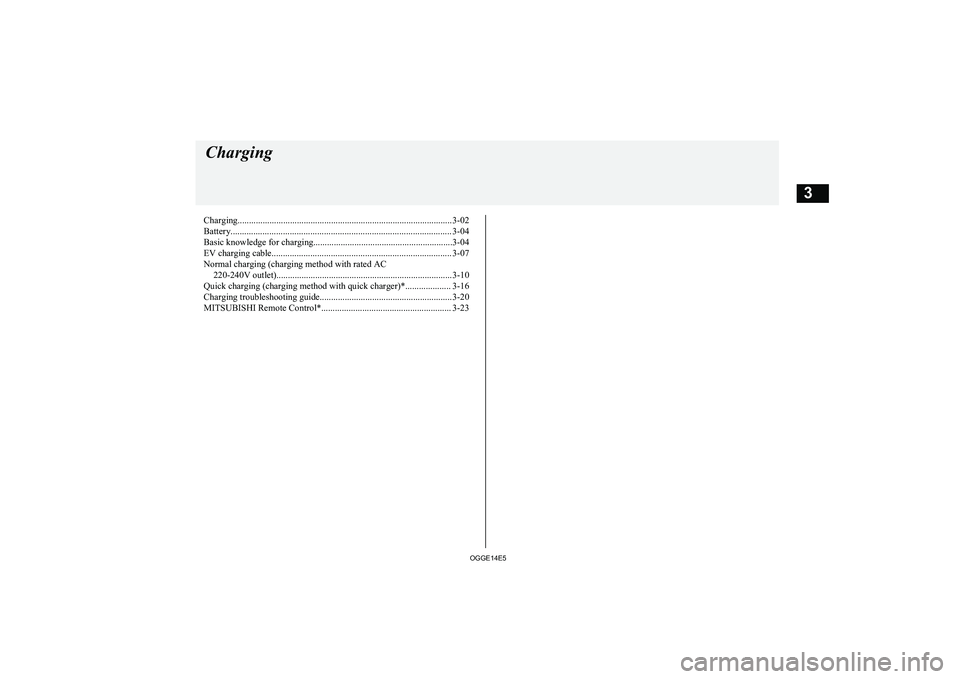
Charging.............................................................................................. 3-02
Battery................................................................................................. 3-04 Basic knowledge for charging.............................................................3-04
EV charging cable............................................................................... 3-07
Normal charging (charging method with rated AC 220-240V outlet).............................................................................3-10
Quick charging (charging method with quick charger)*.................... 3-16
Charging troubleshooting guide.......................................................... 3-20 MITSUBISHI Remote Control*......................................................... 3-23Charging
OGGE14E53
Page 32 of 442
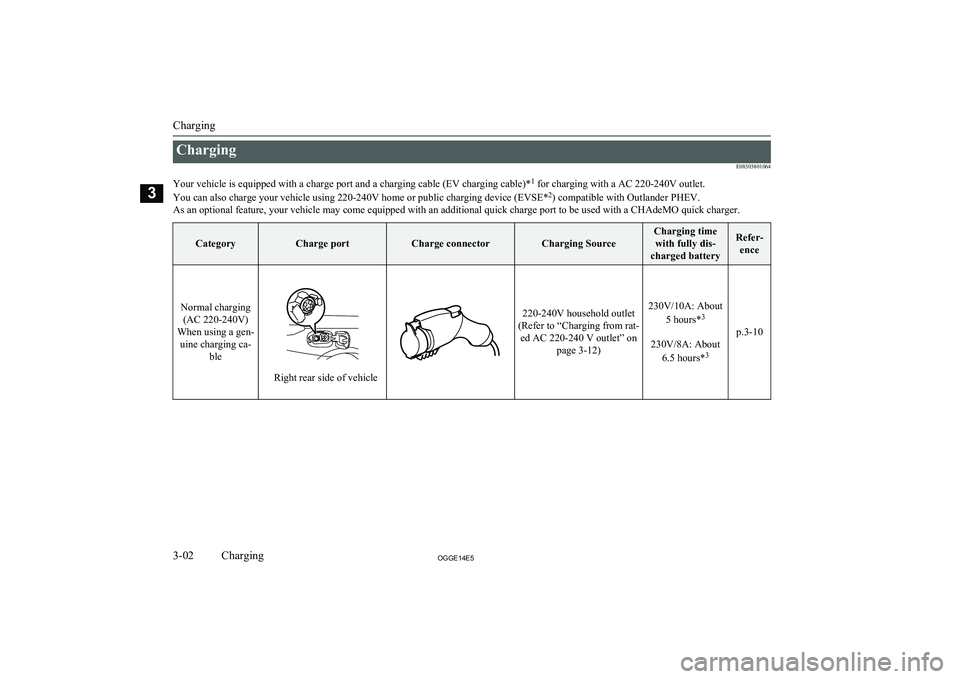
ChargingE08303801064
Your vehicle is equipped with a charge port and a charging cable (EV charging cable)* 1
for charging with a AC 220-240V outlet.
You can also charge your vehicle using 220-240V home or public charging device (EVSE* 2
) compatible with Outlander PHEV.
As an optional feature, your vehicle may come equipped with an additional quick charge port to be used with a CHAdeMO quick charger.CategoryCharge portCharge connectorCharging Source
Charging time with fully dis-
charged batteryRefer- ence
Normal charging(AC 220-240V)
When using a gen- uine charging ca- ble
Right rear side of vehicle
220-240V household outlet
(Refer to “Charging from rat- ed AC 220-240 V outlet” on page 3-12)230V/10A: About
5 hours* 3
230V/8A: About
6.5 hours* 3
p.3-10
Charging
3-02OGGE14E5Charging3
Page 33 of 442
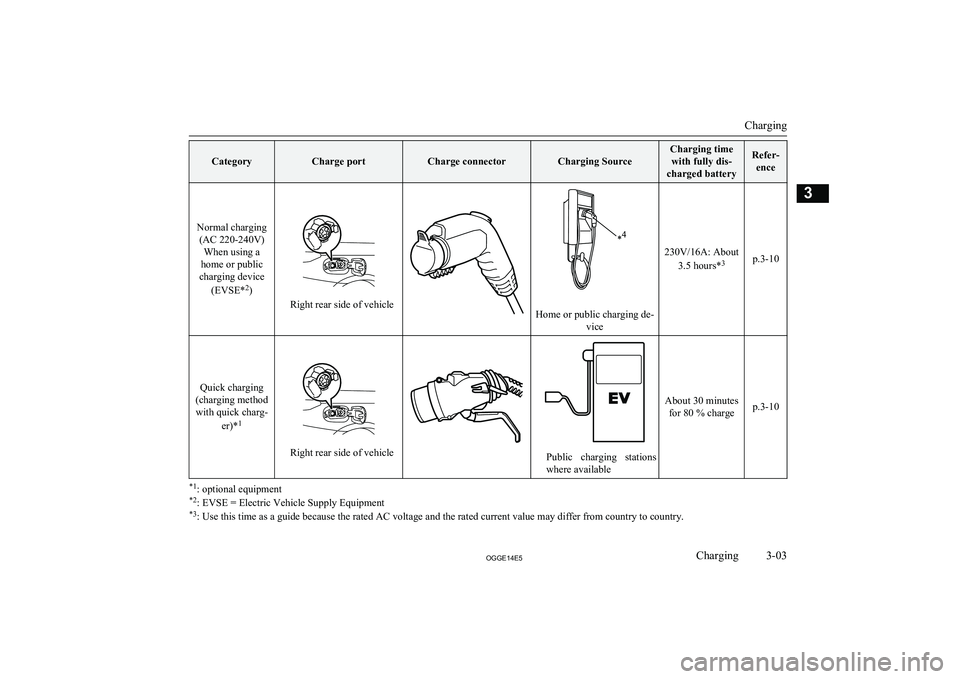
CategoryCharge portCharge connectorCharging Source
Charging timewith fully dis-
charged batteryRefer- ence
Normal charging(AC 220-240V) When using a
home or public
charging device
(EVSE* 2
)
Right rear side of vehicleHome or public charging de-
vice
230V/16A: About
3.5 hours* 3p.3-10
Quick charging
(charging method with quick charg-
er)*1
Right rear side of vehiclePublic charging stations
where available
About 30 minutes for 80 % chargep.3-10
*1 : optional equipment
*2 : EVSE = Electric Vehicle Supply Equipment
*3 : Use this time as a guide because the rated AC voltage and the rated current value may differ from country to country.
Charging
3-03OGGE14E5Charging3
Page 34 of 442
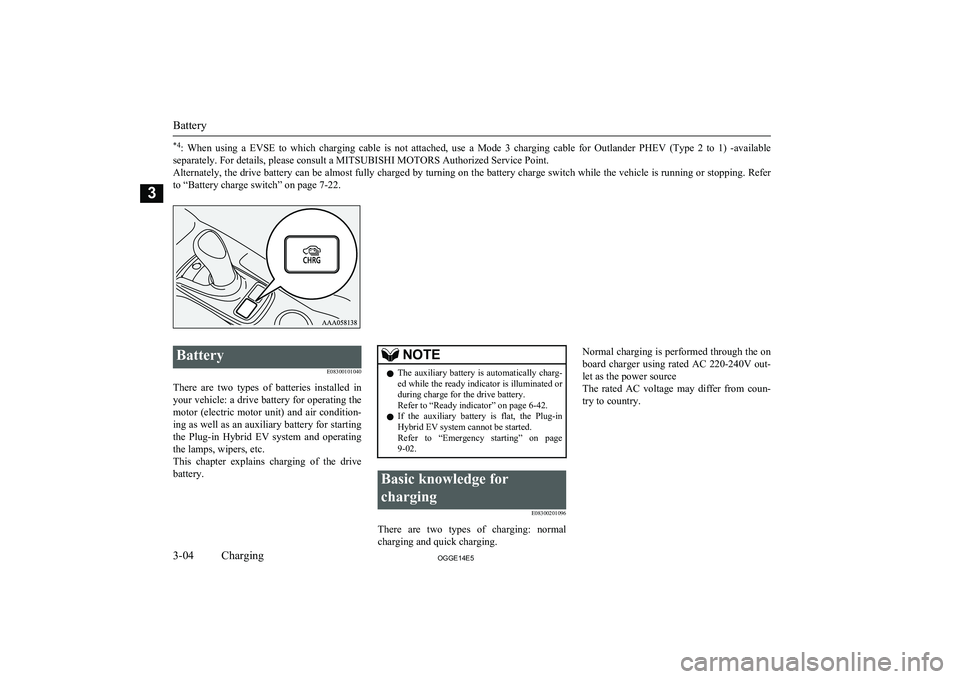
*4: When using a EVSE to which charging cable is not attached, use a Mode 3 charging cable for Outlander PHEV (Type 2 to 1) -available
separately. For details, please consult a MITSUBISHI MOTORS Authorized Service Point.
Alternately, the drive battery can be almost fully charged by turning on the battery charge switch while the vehicle is running or stopping. Refer to “Battery charge switch” on page 7-22.
Battery
E08300101040
There are two types of batteries installed in your vehicle: a drive battery for operating the
motor (electric motor unit) and air condition-
ing as well as an auxiliary battery for starting the Plug-in Hybrid EV system and operatingthe lamps, wipers, etc.
This chapter explains charging of the drive battery.NOTEl The auxiliary battery is automatically charg-
ed while the ready indicator is illuminated orduring charge for the drive battery.
Refer to “Ready indicator” on page 6-42.
l If the auxiliary battery is flat, the Plug-in
Hybrid EV system cannot be started.Refer to “Emergency starting” on page
9-02.Basic knowledge for
charging E08300201096
There are two types of charging: normalcharging and quick charging.
Normal charging is performed through the on
board charger using rated AC 220-240V out-
let as the power source
The rated AC voltage may differ from coun-
try to country.
Battery
3-04OGGE14E5Charging3
Page 35 of 442
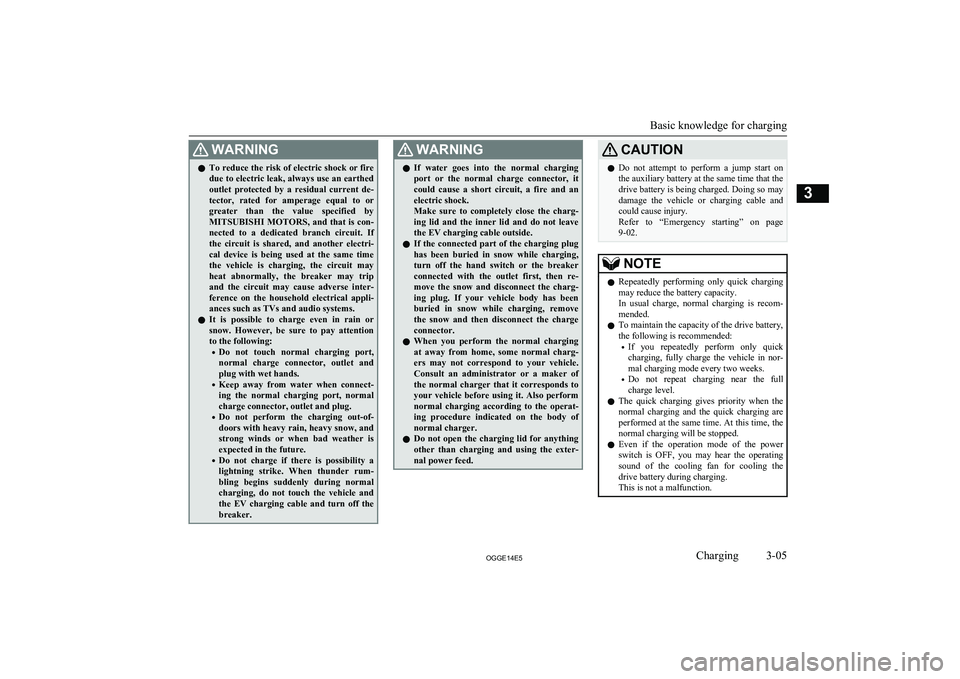
WARNINGlTo reduce the risk of electric shock or fire
due to electric leak, always use an earthed
outlet protected by a residual current de-
tector, rated for amperage equal to or greater than the value specified by MITSUBISHI MOTORS , and that is con-
nected to a dedicated branch circuit. If
the circuit is shared, and another electri- cal device is being used at the same time
the vehicle is charging, the circuit may heat abnormally, the breaker may trip
and the circuit may cause adverse inter-
ference on the household electrical appli- ances such as TVs and audio systems.
l It is possible to charge even in rain or
snow. However, be sure to pay attention
to the following:
• Do not touch normal charging port,
normal charge connector, outlet and plug with wet hands.
• Keep away from water when connect-
ing the normal charging port, normal
charge connector, outlet and plug.
• Do not perform the charging out-of-
doors with heavy rain, heavy snow, and strong winds or when bad weather isexpected in the future.
• Do not charge if there is possibility a
lightning strike. When thunder rum- bling begins suddenly during normal
charging, do not touch the vehicle and the EV charging cable and turn off the
breaker.WARNINGl If water goes into the normal charging
port or the normal charge connector, itcould cause a short circuit, a fire and an electric shock.
Make sure to completely close the charg- ing lid and the inner lid and do not leave
the EV charging cable outside.
l If the connected part of the charging plug
has been buried in snow while charging,
turn off the hand switch or the breaker connected with the outlet first, then re-
move the snow and disconnect the charg- ing plug. If your vehicle body has been
buried in snow while charging, remove the snow and then disconnect the charge
connector.
l When you perform the normal charging
at away from home, some normal charg-ers may not correspond to your vehicle.
Consult an administrator or a maker of the normal charger that it corresponds to
your vehicle before using it. Also perform
normal charging according to the operat-
ing procedure indicated on the body of normal charger.
l Do not open the charging lid for anything
other than charging and using the exter-
nal power feed.CAUTIONl Do not attempt to perform a jump start on
the auxiliary battery at the same time that the
drive battery is being charged. Doing so may
damage the vehicle or charging cable and
could cause injury.
Refer to “Emergency starting” on page 9-02.NOTEl Repeatedly performing only quick charging
may reduce the battery capacity.
In usual charge, normal charging is recom-
mended.
l To maintain the capacity of the drive battery,
the following is recommended:
• If you repeatedly perform only quick
charging, fully charge the vehicle in nor- mal charging mode every two weeks.
• Do not repeat charging near the full
charge level.
l The quick charging gives priority when the
normal charging and the quick charging are performed at the same time. At this time, thenormal charging will be stopped.
l Even if the operation mode of the power
switch is OFF, you may hear the operating sound of the cooling fan for cooling the
drive battery during charging.
This is not a malfunction.
Basic knowledge for charging
3-05OGGE14E5Charging3
Page 36 of 442
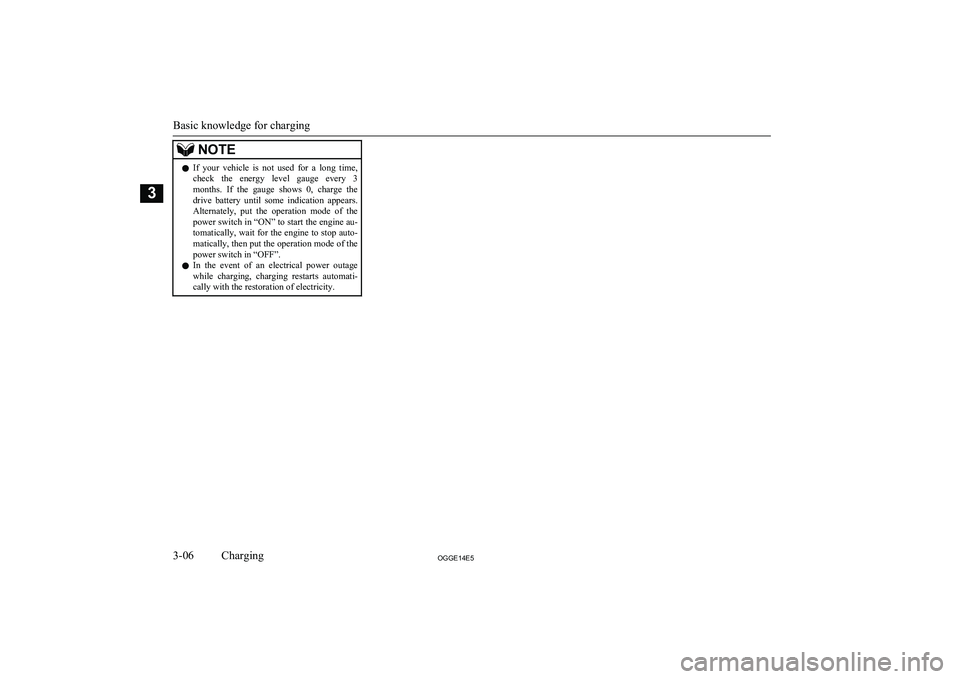
NOTElIf your vehicle is not used for a long time,
check the energy level gauge every 3
months. If the gauge shows 0, charge the drive battery until some indication appears.
Alternately, put the operation mode of the power switch in “ON” to start the engine au-
tomatically, wait for the engine to stop auto- matically, then put the operation mode of the power switch in “OFF”.
l In the event of an electrical power outage
while charging, charging restarts automati-
cally with the restoration of electricity.
Basic knowledge for charging
3-06OGGE14E5Charging3
Page 37 of 442
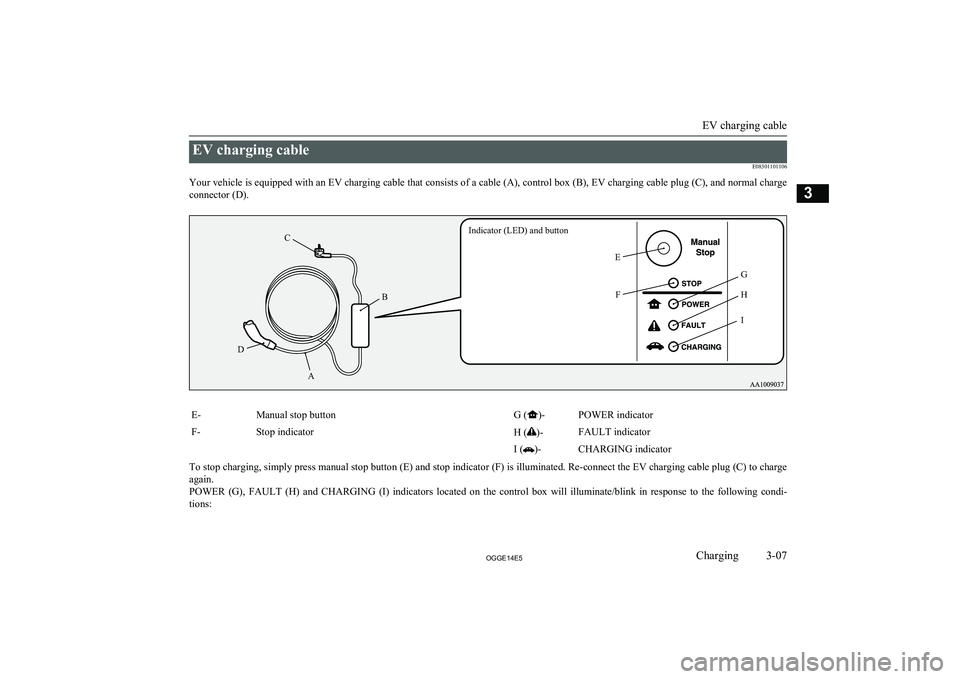
EV charging cableE08301101106
Your vehicle is equipped with an EV charging cable that consists of a cable (A), control box (B), EV charging cable plug (C), and normal charge connector (D).
Indicator (LED) and buttonEABCDFGHIE-Manual stop buttonG ()-POWER indicatorF-Stop indicatorH ()-FAULT indicator I ()-CHARGING indicator
To stop charging, simply press manual stop button (E) and stop indicator (F) is illuminated. Re-connect the EV charging cable plug (C) to charge
again.
POWER (G), FAULT (H) and CHARGING (I) indicators located on the control box will illuminate/blink in response to the following condi- tions:
EV charging cable
3-07OGGE14E5Charging3
Page 38 of 442
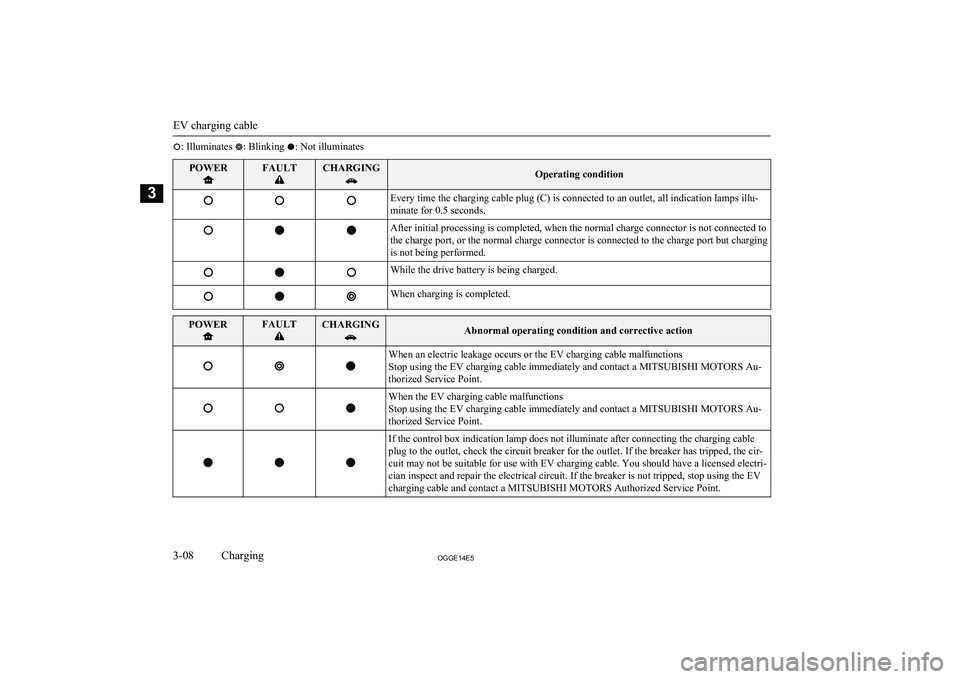
: Illuminates : Blinking : Not illuminatesPOWERFAULTCHARGINGOperating conditionEvery time the charging cable plug (C) is connected to an outlet, all indication lamps illu-
minate for 0.5 seconds.After initial processing is completed, when the normal charge connector is not connected to
the charge port, or the normal charge connector is connected to the charge port but charging
is not being performed.While the drive battery is being charged.When charging is completed.POWERFAULTCHARGINGAbnormal operating condition and corrective actionWhen an electric leakage occurs or the EV charging cable malfunctions
Stop using the EV charging cable immediately and contact a MITSUBISHI MOTORS Au-
thorized Service Point.When the EV charging cable malfunctions
Stop using the EV charging cable immediately and contact a MITSUBISHI MOTORS Au-
thorized Service Point.If the control box indication lamp does not illuminate after connecting the charging cable
plug to the outlet, check the circuit breaker for the outlet. If the breaker has tripped, the cir-
cuit may not be suitable for use with EV charging cable. You should have a licensed electri-
cian inspect and repair the electrical circuit. If the breaker is not tripped, stop using the EV
charging cable and contact a MITSUBISHI MOTORS Authorized Service Point.
EV charging cable
3-08OGGE14E5Charging3
Page 39 of 442
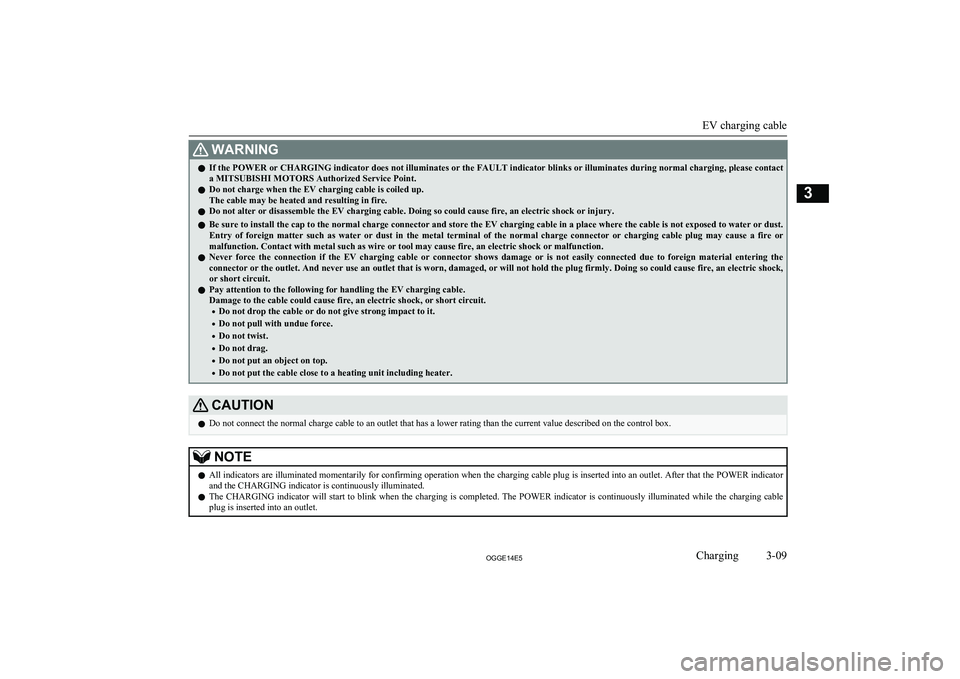
WARNINGlIf the POWER or CHARGING indicator does not illuminates or the FAULT indicator blinks or illuminates during normal charging, please contact
a MITSUBISHI MOTORS Authorized Service Point.
l Do not charge when the EV charging cable is coiled up.
The cable may be heated and resulting in fire.
l Do not alter or disassemble the EV charging cable. Doing so could cause fire, an electric shock or injury.
l Be sure to install the cap to the normal charge connector and store the EV charging cable in a place where the cable is not exposed to water or dust.
Entry of foreign matter such as water or dust in the metal terminal of the normal charge connector or charging cable plug may cause a fire or malfunction. Contact with metal such as wire or tool may cause fire, an electric shock or malfunction.
l Never force the connection if the EV charging cable or connector shows damage or is not easily connected due to foreign material entering the
connector or the outlet. And never use an outlet that is worn, damaged, or will not hold the plug firmly. Doing so could cause fire, an electric shock,
or short circuit.
l Pay attention to the following for handling the EV charging cable.
Damage to the cable could cause fire, an electric shock, or short circuit.
• Do not drop the cable or do not give strong impact to it.
• Do not pull with undue force.
• Do not twist.
• Do not drag.
• Do not put an object on top.
• Do not put the cable close to a heating unit including heater.CAUTIONl Do not connect the normal charge cable to an outlet that has a lower rating than the current value described on the control box.NOTElAll indicators are illuminated momentarily for confirming operation when the charging cable plug is inserted into an outlet. After that the POWER indicator
and the CHARGING indicator is continuously illuminated.
l The CHARGING indicator will start to blink when the charging is completed. The POWER indicator is continuously illuminated while the charging cable
plug is inserted into an outlet.
EV charging cable
3-09OGGE14E5Charging3